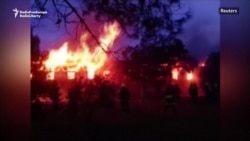BAKU -- Twenty-five drug-rehabilitation patients at a state-run clinic in Baku have been killed by a fire that ripped through their sleeping quarters, described by relatives of victims as a "decrepit" structure where medicated patients were locked inside at night.
Televised footage of the fire early on March 2 showed flames surging through the barred windows of a single-story wooden structure at the Republican Narcological Dispensary in Baku's Xatay district.
Officials said after the blaze was extinguished that the bodies of 25 victims were recovered from the smoldering remains of the building, where 55 bedridden patients were housed. Authorities had initially said at least 30 were killed, but later revised that figure.
Thirty patients were evacuated from the barracks-like building, including four who were hospitalized with serious burns, according to a joint statement from Azerbaijan's Health, Interior, and Emergency Situations ministries and the Prosecutor-General's Office.
The statement said a preliminary investigation suggests that the fire was caused by a short circuit in the building's electrical wiring system at about 6:10 a.m. The fire raged for nearly 2 1/2 hours before it was put out by 10 brigades of firefighters.
Tied To Their Beds
Most patients at the state-run facility are sent there on court orders for the forced treatment of drug addiction, but some patients are admitted voluntarily -- mostly for alcoholism.
Relatives of victims killed by the fire, speaking to RFE/RL on condition of anonymity because of concerns about repercussions in the tightly controlled country, told RFE/RL that only men were being treated at the aging building.
Relatives said the building was in "decrepit" condition, with paint peeling from plywood internal walls and equipment dating back to before the collapse of the Soviet Union in 1991.
Araz Aliguliyev, the former chief physician at the rehabilitation center, told RFE/RL that the building had been used for archives, bookkeeping and "some accounting purposes" until he left the clinic in 2006.
"We didn't keep our patients there," Aliguliyev said. "It was an old building built in the 1990s. I don't know why they were using it to treat patients."
Relatives also said the standard operating procedure was for patients to be locked inside the building for the night after being given medication.
According to government regulations, patients who have "serious psychological problems" related to drug or alcohol addiction can be locked inside their rooms or "fixed to their beds" as part of their treatment.
But in such cases, hospital personnel are obliged to provide security.
A security guard who was on duty outside of the building at the time of the fire, speaking to RFE/RL on condition of anonymity, said he smelled smoke shortly after the blaze began and was able to open a door to let the survivors escape. But by then, he said, it was too late for the 25 men who perished.
Corruption Blamed
After the fire was extinguished, the facility was visited on March 2 by President Ilham Aliyev, Emergency Situations Minister Kamaladdin Heydarov, Interior Minister Ramil Usubov, and Deputy Prime Minister Ali Hasanov.
Authorities allowed only a crew from state television inside the building to record the scene of death and destruction.
The Prosecutor-General’s Office said it had launched a criminal investigation into alleged violations of fire-safety regulations.
Civil activists blamed official corruption, alleging that the failure of authorities to respect and enforce safety regulations is a factor causing large numbers of casualties in increasingly frequent fires.
"Fire-safety regulations were not respected in the hospital's Soviet-era wooden building," the head of the Property Rights civil advocacy group, Aitekin Imranova, said.
"As a result of systemic corruption, an adequate control over the compliance with fire-safety norms is not in place in Azerbaijan," Imranova said.
Rights groups have for a long time accused Alilyev's government of widespread corruption that undermines the functioning of state institutions.
Aliyev's office said on March 2 that he had taken personal control over "recovery and investigative measures" by setting up a government commission to investigate the cause of the fire.
The president’s office said the team of investigators included "experienced staff of the Prosecutor-General's Office, the Interior Ministry, and the Emergency Situations Ministry."
It also said Aliyev had ordered the allocation of financial aid for families of the victims.
Russian President Vladimir Putin sent condolences to Aliyev over the tragedy, the Kremlin said.
There have been several fatal fires at similar secure, state-run hospitals in former Soviet republics where drug addicts or mentally ill people are sent by the state for forced treatment.
Often, such fires occur in old, neglected buildings where many patients are held in lockdown situations.
In December 2006, a fire at a Moscow drug-rehabilitation clinic killed more than 40 female patients.
Russian authorities admitted later that attempts by the women to escape the blaze were hindered by metal bars blocking windows and all but one exit.
Azerbaijan has been plagued by other large-scale fires in the past, in part as a result of aging infrastructure.
In May 2015, 15 people were killed in a blaze at a 16-story residential building in Baku that had been spruced up with flammable Styrofoam facing as part of a “beautification” scheme aimed at improving the country’s global image.
Thousands of people on social media protested against the use of flammable cladding on hundreds of aging Soviet-era apartment blocks across Baku after that fire.
A 1995 Baku subway fire killed 292 people in Azerbaijan’s capital, including 28 children and three rescue workers.
Authorities said that fire was thought to have been caused by an electrical malfunction due to old wiring.
The subway operator and station traffic controller were convicted over that blaze and sentenced to 15 and 10 years in prison, respectively.
Their relatives said the blame should have been placed on the subway system’s managers because they were responsible for the technical condition of the passenger cars.













